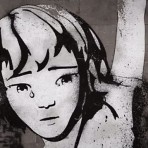 The seasonal practice of burying heads deep into the folds of books is upon us. OK, some of us are burying ourselves in digital devices too, but the point is it’s that time of year when benches, yards, parks and every shady outdoor perch are full of people engaged in the ancient ritual of reading. While dividing my own summer reading unevenly between academic tomes, graphic novels, and narrative prose, I recently happened upon a marvellous book that defies categorization and dare I say, could prove to be the most exhilarating, difficult and enjoyable summer read out of all the others waiting to be loved from among the teetering stacks.
The seasonal practice of burying heads deep into the folds of books is upon us. OK, some of us are burying ourselves in digital devices too, but the point is it’s that time of year when benches, yards, parks and every shady outdoor perch are full of people engaged in the ancient ritual of reading. While dividing my own summer reading unevenly between academic tomes, graphic novels, and narrative prose, I recently happened upon a marvellous book that defies categorization and dare I say, could prove to be the most exhilarating, difficult and enjoyable summer read out of all the others waiting to be loved from among the teetering stacks.
The book is the 453-page collection of creative writing, essays, photography and art called Cultivating Canada: Reconciliation through the lens of Cultural Diversity and there are three things you should know about this door-stopper before proceeding. Number one: It is a diverse creative explosion barely contained between two covers that bracket an intensely inspired and productive conversation about the many intersecting lines of oppression, reconciliation, history, memory and hope. Number two: It is a compendium to the physical, political, cultural and imaginary entity known as Canada, but should be of interest to anyone with an interest in culture, history and communication. Number three: It is a gift from the Aboriginal Healing Foundation (AHF) to you. That’s right the best read you may come across this summer is free.
Cultivating Canada is edited by Ashok Mathur, Johanthan Dewar and Mike DeGagné. Marthur’s introductory essay (following Georges Erasmus’s short introduction) serves as a beautifully rendered blueprint of the volume, the third in a series of three collections “addressing the complex notion of reconciliation in a national landscape” by the AHF. Divided into three sections—Land, Across and Transformation—are 27 original chapters. DeGagné and Dewar provide the soberly optimistic conclusion. The blurb on the back jacket offers this survey of the volume:
The Aboriginal Healing Foundation brings together disparate voices to address how communities—immigrant, racialized, ‘new’ Canadians, and other minoritized groups—related to the intricacies of reconciliation as a concept. Many of the contributors address questions of land, Aboriginal histories, and different trajectories that have led to the current configuration and conglomeration of peoples in this geographic space. And, as a central organizing principle of this collection is artistic practice, specifically in how embedding creative acts within critical responses helps to create a relevant framework of possibilities as we move inexorably into uncertain futures.
With so many contributors hailing from so many walks of life, professions, artistic traditions and histories, it is impossible to thoroughly recount this treasure trove of experience and expression. Each chapter is prefaced with a generous biography of contributing writers and artists who courageously and intelligently tackle the central issues of apology, truth and reconciliation, and cultural difference via personal narrative, essay, interview, photography, visual art and more. Mathur sums up the parts, which he notes elsewhere are indeed greater than their whole, here:
In its sum, Cultivating Canada is both a burst of creative energy and a reconsideration of our pasts. This volume is and is not about reconciliation; although it might refute easy categorization, the central tenet found in the pages that follow is the importance of eliding comfort levels and insisting on a new way of seeing. This vision is neither myopic nor utopic, and any change will not come without intense forms of work from cultural workers, policy makers, and citizens of all walks. But, perhaps, using the various lenses at our disposal, this is how we may cultivate a new future.
From Shirley Bear’s discussion of developing her art “within the family, community, and country” to James Nichols and Sandra Semchuk’s provocative images from Seeds of Lubestrok and Stolen Strength to Jen Budney and Jayce Salloum’s question “What does it mean to be a citizen, let alone an artistic citizen, in Canada…[a] Eurocentric modern sovereignt[y]?” Cultivating Canada’s contributors render a discussion on land, Aboriginal histories, oppression and difference that is at once accessible and complex.
Aside from some academic chatter and pithy pieces announcing launch events (the book launched in March 2011) it is sad but unsurprising that the release of this cultural and political provocation has yielded very little attention in state and corporate media. Cultivating Canada is a powerful affront to the message of state-sanctioned multiculturalism that Harper and settler culture’s elite continue to hammer out. The cultural and political implications and actions of apology, truth and reconciliation are all too often framed and articulated by those in power – that is those who govern and exercise influence with a view toward maintaining the status-quo, a white-defined multiculturalism that “recognizes” history without addressing the ways histories of oppression materialize in contemporary society – but instead enshrine them in policy and law.
The third volume looks at the issue of reconciliation mostly from the perspective of non-Indigenous, non-white Canadians (where other volumes focused on aboriginal voices). The diverse and complex perspectives contained within have carved out a territory inside settler-dominated space that is at once confrontational, creative, and corporeal. Oppression marks the bodies of those who survive it, and this collection forces a look at those scars, while directing the reader’s gaze away from assimilation, white-defined state multiculturalism and guilt. The boundaries that are shattered and thoughtfully fragmented reconfigure as inclusive spaces with perforated borders, mapping not just a nation or a state, but a place both ugly and beautiful in its difference and diversity – a place and space we all can call home.
Cultivating Canada should be on the reading list of every undergraduate student and should be handed to every new and returning Members of Parliament as Ottawa becomes full with bureaucratic bodies, accompanied as they are with empty progressive vision and action.
Racism is real and ubiquitous in Canada, we only need to look at the state and corporate media to come to that conclusion. With that debate behind us, it is high time to turn our collective attention to the work of those addressing and redressing the cultural, political and historical lines of oppression that demarcate Canada. A good place to start is with the talented, insightful and brilliant individuals whose art and intellect is captured in Cultivating Canada. Download your own copy, print it out (or not), grab a blanket, balcony or bench and get ready for a summer read that just might change your life, and Canada itself.
































